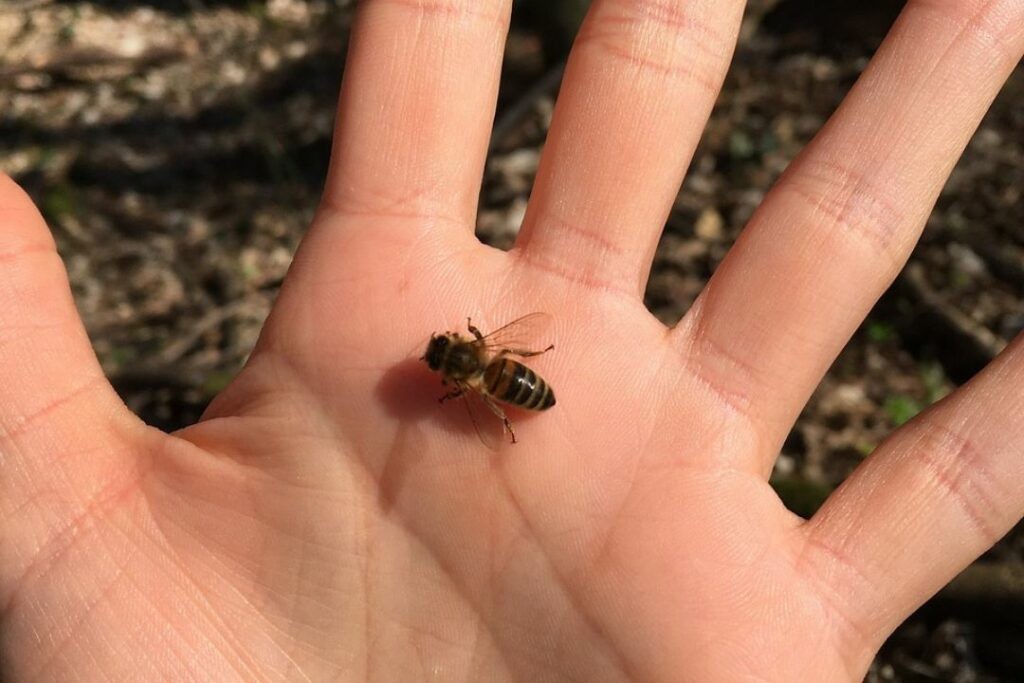The idea of keeping bees as pets might sound unusual at first. Typically, when we think of pets, we imagine cuddly animals that enjoy human interaction. Bees, on the other hand, are often seen as busy insects buzzing around flowers, not creatures we’d consider petting.
However, there’s growing interest in the world of bees, and you might have seen videos online of people gently interacting with these fascinating insects. This raises the question: can you actually pet a honey bee? Is it safe for you, and is it good for the bee? Let’s explore this topic and understand the reality of interacting with honey bees.
Should You Ever Keep a Honey Bee as a Pet?
Absolutely not. You should never attempt to keep a honey bee, or any bee for that matter, as a pet. Honey bees are wild animals that play a vital role in our ecosystem. They need to be free to fly outdoors, collect nectar and pollen, and live within their colony.
Whether it’s a honey bee, a solitary bee, or a bumblebee, keeping them confined is detrimental to their well-being and disrupts the natural balance. Treating bees as pets stems from a misunderstanding of their needs and natural behaviors. Those who suggest bees make good pets are unfortunately misinformed about the complex lives of these insects.
Honey bees thrive in natural environments such as gardens, meadows, and woodlands. Confining them indoors, away from their colony and foraging grounds, is harmful. Bees are already facing numerous challenges, including habitat loss and pesticide use. Removing a worker bee from its hive or nest to keep as a “pet” only adds to these pressures and deprives the colony of essential resources.
What about wasps? Can they be pets?
Similar to bees, wasps should not be kept as pets. Despite often having a less favorable reputation, wasps, like bees, are social insects crucial to the environment. They can even be quite tolerant of humans, often coming close without aggression.
However, this tolerance should not be mistaken as an invitation to domesticate them. Just like bees, wasps have specific needs that cannot be met in a domestic setting. Keeping them as pets is detrimental for the same reasons it is harmful to keep bees: they belong in their natural environment, contributing to their ecosystem.
Can You Pet a Honey Bee? Understanding the Risks
You might have come across videos online showing people stroking bumblebees or gently touching bees, making it seem like petting a bee is possible and even enjoyable. However, while these interactions might look harmless, it’s important to understand the potential risks and why experts strongly advise against petting honey bees.
The Risk of Bee Stings
Honey bees, like many bee species, possess a barbed stinger as a defense mechanism against predators and perceived threats. This stinger is designed to protect themselves and their colony from danger.
When you attempt to pet a honey bee, even with the gentlest intentions, there is a risk of triggering this defensive response. If a bee feels threatened by your touch, it may sting you. A bee sting can be painful and cause allergic reactions in some individuals. Furthermore, when a honey bee stings, its barbed stinger gets lodged in the skin, causing fatal injury to the bee itself. Therefore, attempting to pet a bee risks harm to both you and the bee.
Potential Damage to the Bee
Honey bees are incredibly delicate creatures. Their bodies and wings are fragile, and even the softest human touch can cause unintentional harm. Our skin, though seemingly smooth to us, is quite rough at a microscopic level and can easily damage a bee’s delicate wings.
Handling a honey bee or touching its wings can lead to tears, deformities, or the removal of essential scales on the wings. Even minor wing damage can significantly impair a bee’s ability to fly, making it difficult or impossible for it to forage for food and contribute to its colony.
Moreover, our fingers naturally secrete oils and can carry contaminants such as lotions, soaps, or residues. Transferring these substances to a bee’s wings can interfere with their aerodynamics and flight capabilities. It can also introduce harmful substances into the bee’s nest or hive when it returns, potentially affecting the entire colony.
Causing Unnecessary Stress to Honey Bees
Imagine a giant hand suddenly appearing from above, blocking out the sun, and reaching down to pat your head. It would be startling and potentially frightening, right?
This is likely how a honey bee perceives our attempts to pet it. From a bee’s perspective, a large hand approaching them can be incredibly alarming. It’s a sensory overload that can be perceived as a threat, causing significant stress to the bee.
This stress response can lead to unnecessary upset and agitation in the bee. At best, the bee will simply fly away to escape what it perceives as danger. At worst, feeling threatened, it might resort to stinging in defense. Therefore, petting a honey bee, even with good intentions, can cause undue stress and potentially trigger a defensive reaction.
Honey Bees in Managed Hives: Are They Pets?
Even when honey bees are kept in managed hives by beekeepers, they are not considered pets in the traditional sense. Beekeeping is more accurately described as animal husbandry or livestock management rather than pet ownership.
Beekeepers provide hives as suitable homes for honey bees and manage their colonies to ensure their health and productivity. However, honey bees in these hives remain wild animals. They forage freely in the surrounding environment, collect their own food, and follow their natural instincts. The relationship is one of care and management, not domestication like with cats or dogs. Bees in hives are not dependent on humans for moment-to-moment survival in the same way as domesticated pets.
Better Ways to Interact with and Help Honey Bees
Instead of trying to pet honey bees, which can be harmful and stressful for them, there are many positive and beneficial ways to support these vital pollinators. Here are some bee-friendly actions you can take:
Create a Bee-Friendly Garden
Planting a garden with native and bee-friendly plants is one of the best ways to help honey bees and other pollinators. Choose plants that provide ample nectar and pollen sources. Select a variety of plants that bloom at different times throughout the year to ensure a continuous food supply for bees from early spring to late fall.
Provide a Water Source
Honey bees need water, especially during hot weather. Set up a shallow dish of water with pebbles, marbles, or corks placed inside. These provide landing spots for bees, allowing them to drink safely without the risk of drowning.
Reduce or Eliminate Pesticide Use
Many pesticides, even those considered “bee-friendly,” can be harmful to honey bees and other beneficial insects. Opt for natural and organic pest control methods in your garden. Consider tolerating some level of pest damage to support a healthier ecosystem for bees and other wildlife.
Support Local Beekeepers and Honey
Purchasing local honey and beeswax products directly supports beekeepers in your area. Local beekeepers play a crucial role in maintaining healthy honey bee populations and contributing to pollination in your community.
Educate Yourself and Advocate for Bees
Learn more about the importance of honey bees and the challenges they face, such as habitat loss, pesticide exposure, and climate change. Spread awareness among your friends and family and advocate for policies and initiatives that protect bees and their habitats. Explore resources like bee blogs and conservation websites to deepen your understanding.
Build Bee Habitats
Consider creating bee hotels or nesting sites, particularly for solitary bees, which often nest in cavities. Leave some areas of your garden to grow wild and undisturbed, providing natural nesting habitats and resources for various bee species.
Observe and Appreciate from a Distance
Enjoy watching honey bees and other pollinators in your garden or natural environments without attempting to touch or handle them. Observe their fascinating behaviors, their foraging activities, and their crucial role in pollination.
Support Bee Conservation Organizations
Donate to or volunteer with organizations dedicated to bee research, conservation, and education. These organizations work to protect bees and their habitats through research, advocacy, and habitat restoration projects.
Use Bee Revival Tools Responsibly
If you encounter a bee that appears exhausted or struggling, you can use bee revival kits or a simple sugar-water solution to offer a quick energy boost. However, always do so responsibly and only when necessary, ensuring you are not causing further stress or harm to the bee.
Stay Informed about Bee Health
Keep up-to-date with the latest research and news regarding bee health and conservation. The more informed you are, the more effectively you can contribute to bee well-being.
In Conclusion: Appreciate Bees from a Respectful Distance
While the idea of petting a honey bee might stem from curiosity or affection for these insects, it’s crucial to understand that they are not pets and should not be treated as such. Petting a bee is not beneficial and can be harmful to both you and the bee.
Instead of attempting to pet honey bees, we should focus on creating bee-friendly environments, supporting their populations through conservation efforts, and appreciating them from a respectful distance. By understanding their needs and respecting their wild nature, we can contribute to the well-being of honey bees and the crucial role they play in our ecosystem.
To delve deeper into the fascinating world of bees and other insects in your garden, explore further resources and educational materials. Learning more about these creatures will enhance your appreciation for their vital contributions to our planet.

